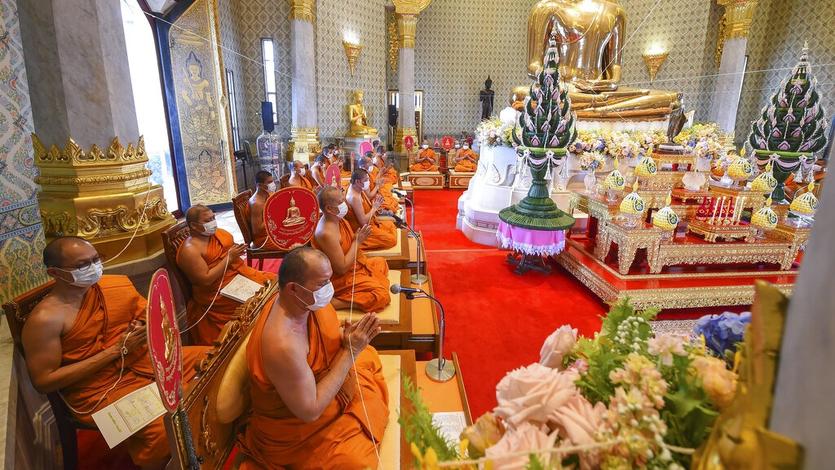 Buddhist monks wear face masks to help protect themselves from the coronavirus as they pray at the Traimit Temple in Bangkok, Thailand, in Bangkok, Thailand, May 11, 2021. (THANACHOTE THANAWIKRAN / AP)
Buddhist monks wear face masks to help protect themselves from the coronavirus as they pray at the Traimit Temple in Bangkok, Thailand, in Bangkok, Thailand, May 11, 2021. (THANACHOTE THANAWIKRAN / AP)
The threat of more transmissible coronavirus variants, including one first detected in India, poses Southeast Asia with its most severe challenge since the COVID-19 pandemic began, experts say.
“The variant (circulating in India) has now been found in most Southeast Asian countries, many of which have only developing health systems,” said Nicholas Thomas, associate professor in health security at City University of Hong Kong.
“There is definitely a risk,” Thomas said, adding that the region has already seen an uptick in other variants.
Thailand reported its first case of the B.1.617 variant — believed to have caused the rapid acceleration of an explosive surge in India — on May 10,
according to Bangkok Post.
The report came as Thailand began experiencing a nationwide outbreak in early April — fuelled by a fast-spreading variant first identified in the United Kingdom — bringing the country’s total case tally to more than 113,000 as of May 18, more than triple the number before the latest infection wave began.
“What is worrying us now is the possible arrival of this new coronavirus variant through the country’s border areas, given the fact that more than 15,000 illegal migrants have sneaked in over the past four months,” said Prasit Watanapa, dean of the Faculty of Medicine at Siriraj Hospital, as quoted by the Bangkok Post.
The B.1.617 variant has spread to 44 countries with a possible presence in five more, the World Health Organization said in its weekly update on May 12. This includes Singapore, Indonesia, Malaysia, Thailand and Cambodia.
The WHO declared B.1.617 a variant of global concern on May 10, the fourth variant to be designated so after those first detected in the UK, South Africa and Brazil. It has three different sub-lineages: B.1.617.1, B.1.617.2 and B.1.617.3.
The WHO said the variant might also be resistant to certain antibodies, including from vaccines.
In Vietnam, after confirming its first local transmission of the B.1.617 variant, the government extended mandatory quarantines from 14 to 21 days for overseas travelers and contacts of confirmed COVID-19 cases.
Maurizio Trevisan, dean of the College of Health Sciences at VinUniversity in Hanoi, said Vietnam is experiencing “the most difficult wave” of the pandemic.
By May 14, Vietnam recorded 2,282 domestically transmitted cases, including 712 detected since the latest outbreak started on April 29, when the country reported its first locally transmitted COVID-19 cases in 35 days.
Yet with older variants still circulating, B.1.617 is not solely responsible for the recent surge, Trevisan told China Daily.
In Vietnam, nearly 86 percent of positive cases imported from Cambodia carry the B.1.1.7 variant, first identified in the UK, and over 14 percent carry B.1.351, first detected in South Africa, according to online media VnExpress, citing findings by the Pasteur Institute in Ho Chi Minh City.
In Cambodia, 121 cases of variants first detected in the UK and one variant first detected in India have been identified between Feb 14 and May 9, Phnom Penh Post reported on May 12.
By May 18, Cambodia’s national case tally hit 22,889. The country only had less than 500 cases before community transmission on Feb 20 triggered its third wave.
“(The recent surge) proved the fact that individual countries, even though they do very well on their own, they don’t live in isolation … what happened to the other part of the world has a big impact on everybody,” said Trevisan. “We are not going to be able to really address this epidemic until all the countries in the world address this issue.”
Noting many Southeast Asian countries have implemented stringent measures to prevent variants from spreading, Thomas from CityU said the region, for the moment, is better prepared.
However, he pointed out that “the border between India and Myanmar by land and by sea is quite porous,” and that the latter’s COVID-19 situation is “probably a big black spot” considering its political situation.
Thomas appreciates China’s assistance to Southeast Asia amid the surge in infections.
Cambodia received a third batch of COVID-19 vaccines from Chinese biopharmaceutical company Sinovac on May 11, according to Xinhua News Agency.
“The vaccine’s arrival today is another testament to the unbreakable iron-clad friendship between our two countries,” Cambodia’s Health Ministry Secretary of State Yok Sambath told reporters.
In Laos, besides medical supplies and experts sent from China, the country received a new aid package worth 15.5 billion kip ($1.64 million) provided by the Chinese government on May 10, according to Vientiane Times.


